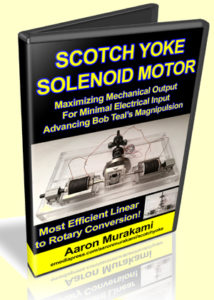
Scotch Yoke Solenoid Motor by Aaron Murakami, Bob Teal’s Magnipulsion motor ran on a car battery and generated enough mechanical work to run a 20 ton conveyor belt for 6 months and the battery never went dead!
His motor used solenoid coils that when charged, they would pull an iron rod into them and these rods turned a conventional crankshaft. When the coils were turned off, he recaptured almost all the electricity and used it over and over and over. Despite the poor mechanical performance of the crankshaft that is just like the ones in most of our automobiles, he still had those profound results.
When I first learned about the Bourke Engine about 8 years ago, the most efficient gasoline engine ever developed, the reciprocating motion was turned into rotary motion with a very intriguing mechanism called a Scotch Yoke. While that yoke is not new and was not even new when Russell Bourke used it in his opposing piston engine, it helped to take his efficiency to levels that are claimed to be impossible.
Instantly, I knew that marrying the Scotch Yoke mechanism to a Bob Teal type electromagnetic motor would be the ultimate combination and this presentation shows the concepts, timing mechanism and a masterfully built Scotch Yoke with iron rods going into solenoid coils with only a couple thousand’s inch gap!
The concept of putting these two things together is mine, Peter Lindemann who has studied the Bob Teal technology for years and is actually the inspiration for his variable reluctance motor that Eric Dollard tested at 108% back in the 1980’s came up with the timing mechanism, Ken Flanigan did all of the machining and Graham Gunderson is helping to design the driver circuit. For any of you that have wanted to see a collaboration between some of the presenters at the conference, this is it.
What is presented is the history of the Bob Teal motor and how it relates to this project, where we are at with the project at the moment and where we’re going with it. Proceeds from this presentation will go to funding the rest of the project so we can open source it all and bring it straight to the people!
Make sure to get a copy so you can learn about the most efficient way to turn reciprocating motion into rotary, which can pump water, drive you around town (scaled up) or other mechanical applications with the minimum amount of electricity. Release date – August 25, 2016. Learn more: Scotch Yoke Solenoid Motor
His motor used solenoid coils that when charged, they would pull an iron rod into them and these rods turned a conventional crankshaft. When the coils were turned off, he recaptured almost all the electricity and used it over and over and over. Despite the poor mechanical performance of the crankshaft that is just like the ones in most of our automobiles, he still had those profound results.
When I first learned about the Bourke Engine about 8 years ago, the most efficient gasoline engine ever developed, the reciprocating motion was turned into rotary motion with a very intriguing mechanism called a Scotch Yoke. While that yoke is not new and was not even new when Russell Bourke used it in his opposing piston engine, it helped to take his efficiency to levels that are claimed to be impossible.
Instantly, I knew that marrying the Scotch Yoke mechanism to a Bob Teal type electromagnetic motor would be the ultimate combination and this presentation shows the concepts, timing mechanism and a masterfully built Scotch Yoke with iron rods going into solenoid coils with only a couple thousand’s inch gap!
The concept of putting these two things together is mine, Peter Lindemann who has studied the Bob Teal technology for years and is actually the inspiration for his variable reluctance motor that Eric Dollard tested at 108% back in the 1980’s came up with the timing mechanism, Ken Flanigan did all of the machining and Graham Gunderson is helping to design the driver circuit. For any of you that have wanted to see a collaboration between some of the presenters at the conference, this is it.
What is presented is the history of the Bob Teal motor and how it relates to this project, where we are at with the project at the moment and where we’re going with it. Proceeds from this presentation will go to funding the rest of the project so we can open source it all and bring it straight to the people!
Make sure to get a copy so you can learn about the most efficient way to turn reciprocating motion into rotary, which can pump water, drive you around town (scaled up) or other mechanical applications with the minimum amount of electricity. Release date – August 25, 2016. Learn more: Scotch Yoke Solenoid Motor

Comment